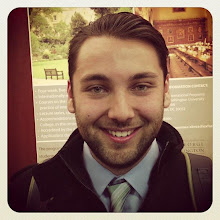I am now sitting at Vilnius Airport in Lithuania, about to fly back to Copenhagen, and this is the first time I have had Internet access all week. I wrote several blog posts while I was in Lithuania this past week. Here is the blog I wrote on my second night in Vilnius.
After spending about a day and a half in Vilnius, the Capital city of Lithuania, I would have to say that my overall impressions of the city are very positive. It has such and interesting history and character, which I very much enjoy having the opportunity to experience. But to be honest, one of the best things about this city is that it is so much cheaper than Copenhagen. This may sound strange, but it almost feels like going home – not having to spend and arm and a leg for food. Just a comparison; a cup of hot chocolate might cost 35 kroner in Denmark, about $7. In Sweden it might cost about 35 Swedish kronor, which is more like $5. Here in Lithuania we found a great restaurant that serves “kakava” for only 6 litas, or about $2.50, which is an amazing deal. Last night, my friends and I ate at a restaurant that cost $15 for the four of us, including bottle waters! It is such a relief to not feel so guilty about spending all of our money on food and drinks.
Anyway, yesterday we went on a walking tour of the city. Vilnius is often called the city of churches, and for good reason. We saw some many amazing churches. This country is made up predominantly of Roman Catholics, who of course love gregarious baroque houses of prayer. However, there are also a large number of Russian Orthodox churches, some Lutheran and other Protestant churches, as well as one synagogue. After walking to city and grabbing a quick – and cheap – dinner, we got dressed-up and went to the Lithuanian National Philharmonic Orchestra, which performed a work by the national composer, which was sung in Lithuanian, Polish, Latin, and Yiddish. The piece was definitely not what we were expecting, and was a little strange. Nevertheless it was a good cultural experience.
On the morning of our second day we went to a meeting at the Lithuanian Presidential Palace. We met with Virginija Budiene, a cultural chief advisor to newly elected president Dalia Grybauskaitė, the first female president of Lithuania. We discussed with here a number of different topics, including migration in Lithuania, as well as the different cultural minorities. Overall, it was an interesting and informative meeting. I must admit though, that the words “nuclear power plant” sound so much more sinister when pronounced in a Lithuanian (read: uncannily Russian) accent. I couldn’t help but think of old movies about Soviet Russia during the cold war. Nevertheless, Ms. Budiene was a wonderful host who got us thinking about what Lithuania is all about.
That afternoon, we were on our own to wonder the city. We did some souvenir shopping, at wonderful Lithuanian prices, and then visited Užupis. I am going to save a discussion of Užupis for my next blog, and will end with some photos I have taken of ‘The City of Churches.’
'The Gates of Dawn' - also the Church of Our Mother of Mercy

A Russian Orthodox Church

A view of the northern part of the city

A chapel inside the Church of St. Francis

A courtyard at the Presidential Palace

Street Art


























